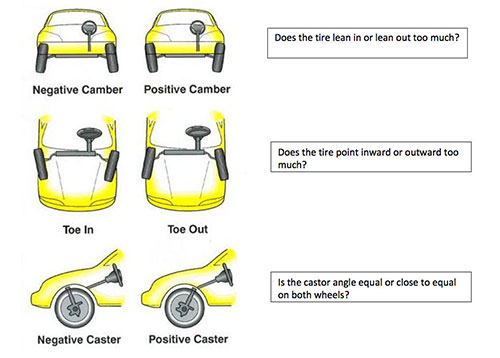
Having your wheel alignment unimpaired and intact goes hand in hand with drivability. A vehicle is not drivable if the wheel alignment is off. A driver should always be controlling the car, and if the wheel alignment is off, you are driving a car that has the possibility of fighting your control and controlling you altogether. As a driver, there is no way to predict what someone else on the road will do, the only controllable factor is yourself. If your car’s wheel alignment is off, you are adding to uncontrolled factors on the road risking the safety of yourself and any one you are in contact with. Misalignment can result from a variety of daily driving occurrences which are important to recognize.
COMMON DRIVING SITUATION THAT CAN CAUSE MISALIGNMENT
The possible causes that can affect your wheel alignment are very common daily driving occurrences. In fact, the act of driving itself is a cause because wear and tear on your tires can progressively influence your wheel alignment. Some other potential influences include:
- Potholes
- Speeding over speed bumps
- Road accidents
- Worn out parts
- Hitting a curb
The more severe the occurrence of one of these potential alignment influences, the more severe your wheel alignment is affected. Similarly, a series or combination of the very common events over a duration of time can just as heavily influence your wheel alignment.
WARNING SIGNS OF MISALIGNMENT
There are some key warning signings to look out for. Signs you are dealing with problematic wheel alignment include:
- Crooked steering wheel
- Vehicle pulling
- Unleveled tires
- Tire wear
- Tire squealing
Determining how to repair the wheel alignment of a vehicle is specific to the condition, situation, and type of vehicle being examined. The type of wheel alignment your vehicle needs to be determined professionally by a mechanic. This may be dependent on the specific damage done to your vehicle. When bringing your vehicle in, depending on these factors, the mechanic may have a series of manual processes he or she goes through and then should ultimately connect the car to an alignment machine that will specify the necessary type of adjustment needed to be performed. There are three different types of wheel alignment procedures.
3 TYPES OF WHEEL ALIGNMENT:
- When the front axle is adjusted, a front-end wheel alignment was completed.
- When all wheels are checked and a front-end alignment is conducted, it is a thrust alignment
- When the rear axle angles are arranged and a front-end and thrust are conducted, it is a four-wheel alignment.
A professional will determine which alignment procedure is necessary for your vehicle. It is important as a driver or owner of an automotive vehicle to be proactive and aware of possible warning signs. Regardless if a warning sign is noticed, routine maintenance should include wheel alignment examination as it is a driving factor that is easily influenced.